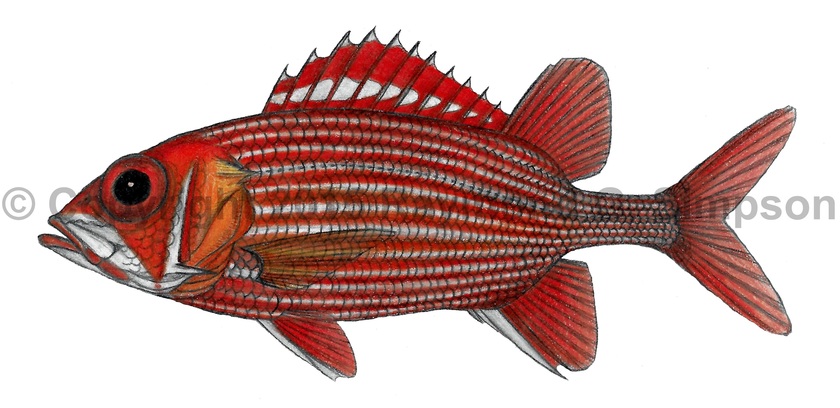
Common Name
Red Squirrelfish
Year Described
Cuvier, 1829
Identification
Dorsal Fin: XI, 14-15
Anal Fin: IV, 10
Pectoral Fin:
Lateral Line Scales: 48-51
Vertebrae: 27 (total)
Gill Rakers: 23
Body oval with a flattened ventrum and convex dorsal profile. Head with small serrations on suborbital but no strong spines. Snout blunt with a convex frontal profile. Eye large. Preopercle with a strong spine at the angle. Opercle with 2 strong spines and additional serrations on margin. Mouth fairly small; reaching middle of orbit. Dorsal fins separate with strong notch. Rear dorsal, anal, and caudal fins rounded. Last dorsal spine shorter than second to last spine. Third anal spine strong. Scales obvious and rough.
Color
Body bright red with several white parallel stripes following scale rows. A yellowish wash is common in the red area on the opercle and lower body. A V-shaped white marking runs along the preopercle and onto maxilla. Spiny dorsal fin bright red with white tips and a median line of white blotches. Other fins bright red with clear membranes. Anterior anal and pelvic fin white.
Size
Maximum size to 25cm SL.
Habitat
Inhabits coral and rocky reefs, usually under 200m. Caribbean records observed at around 10m in caves.
Range
Known in the W. Atlantic only from two records from St. Vincent and San Andres, Colombia. At least a few fish were observed at each location.
References
Whitehead, P.J.P. , M.-L. Bauchot, J.-C. Hureau, J.G. Nielsen and E. Tortonese. 1986. Fishes of the North-eastern Atlantic and the Mediterranean. Vol. I-III. UNESCO. Fishes of the North-eastern Atlantic and the Mediterranean.
Wilk, Kr., Ke. Wilk, & D. Greenfield. 2005. First record of the Eastern Atlantic squirrelfish Sargocentron hastatum (Holocentridae) from the Western Atlantic Ocean. Proceedings of the California Academy of Sciences: 56: 86-87
Other Notes
The identification of these squirrelfishes is unclear. Individuals pictured from the Caribbean are duller than ones from the Eastern Atlantic with less contrast on the body bands (more red and pink). Further sampling is needed to determine if they represent S. hastatum, an unmarked S. poco, a hybrid of two species, or an undescribed species.